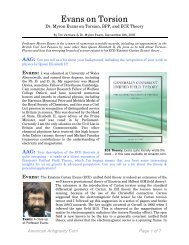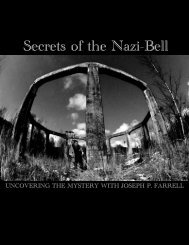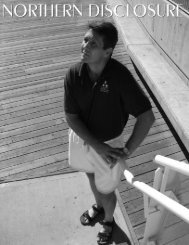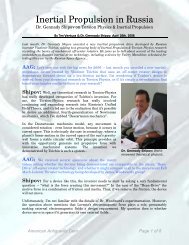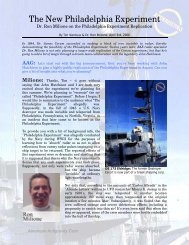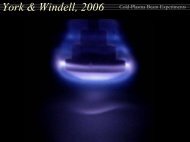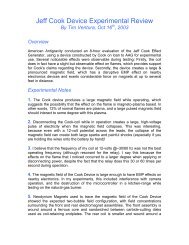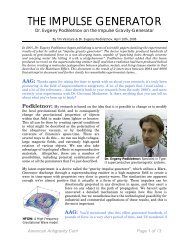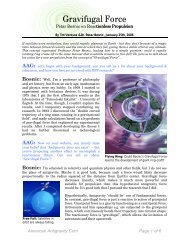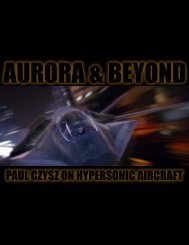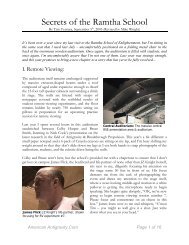Larry-Maurer-Intervi.. - American Antigravity
Larry-Maurer-Intervi.. - American Antigravity
Larry-Maurer-Intervi.. - American Antigravity
- No tags were found...
You also want an ePaper? Increase the reach of your titles
YUMPU automatically turns print PDFs into web optimized ePapers that Google loves.
whether they want to assist us in our campaign to help blind people to navigate in and aroundthe Portland area. City officials suggest that we first test a two or three block area in downtownPortland for the system. My thoughts are since the jail/probationary GPS system is already inplace and in use everyday that it wouldn’t take much to set up a similar system for not only blindpersons but severely disabled or mental patients to assist in their navigation around the city. Ihave talked to many blind people who, virtually everyone I talked to are seriously interested inour ideas for the navigation system. It will take some time to see who will supply the money forthe headphones and guidance personnel, etc.We have another area of concern and that is tobetter house the many growing homeless personsin Portland with our “Tubes” design. The Tubesbeing an enclosed 6 ft. high x 5 ft. wide X 8 ft. longenclosed area of a fiberglass enclosure with anopening door at the front can be stacked two highin long rows. The Tubes design is not new it is verypopular in Japan and the Orient especially atairports for travelers for an inexpensive overnightstay. We have received much attention from localhumanitarian groups, Central City Concern (CCC)and Transitions Projects Inc. (TPI) who realize thatthese enclosed tubes will cut down on diseases &noises, create better security and are better suitedWakefield: Sublight-propulsion achievedusing the wakefield laser propulsion system.to the individual with a radio & TV inside. This is another idea that has been “simmering” on theplates of city officials to decide what to do about funding, etc.We have our basic team of individuals except with the recent passing of our Corporate attorneyDennis F. Tripp, who has been with us for over ten years who died in less than 8 weeks fromThyroid cancer and Andrew Moore, who was one of our Vice Presidents. Andrew created nearlyall of the graphics for our web site, posters, movies, etc. and we will seriously miss both Andrewand Dennis a lot. This has been devastating to us. I might add here also that we were gettingserious attention from Eugene Malove for sponsoring a grant for Unitel right up until the time ofhis recent death. We just have to pick up where we left off and keep on going with the personnelwe have to date. Although Doug Starfield and Bryan Workman haven’t been in touch with us asof late they are still listed as official Vice Presidents. David A. Carter has recently been dulyelected as Corporate Secretary and as been working with us to publish and sell our books. Itshard to get anything done with out proper funding however we believe that through properenlightenment of our corporate endeavors to the general public we will succeed in all of ourprojects, no matter how far advanced they may seem.AAG: I know that yourself and Michael Miller have put a lot of time into explaining theUnitel technology in simplistic terms, but you've created such a complex & refined design that Ithink there's still a lot of confusion about it. Let's review some of the fundamentals about yourmost well known project - the Unitel Starship. Can you give us an overview of the features &performance that you expect from this design?<strong>Maurer</strong>: Well Tim, we have been acquiring more and more support from the scientificcommunity as of late, especially in the basic design area for our Chirp Pulsed Amplified (CPA)laser system. We have been in touch with Professor Chandrashekhar Joshi of UCLA who tookover where John Butler left off with us as John passed away a year or two ago. I had talked toProf. Butler at UCLA on the telephone and with email correspondences, who was in agreementwith our design and CPA technology that he mentioned to me then that he was working on. Prof.Joshi is the Author of the article Plasma Accelerators”- A new method of particle acceleration in<strong>American</strong> <strong>Antigravity</strong>.Com Page 4 of 11
which the particles "surf" on a wave of plasma promises to unleash a wealth of applications inthis year’s February Issue of Scientific <strong>American</strong> magazine. I had contacted John Butler at UCLAas we had tried to contact Prof. Donald Umstadter at Univerity of Michigan after reviewing hisCPA laser system design in the May 2002 issue Scientific <strong>American</strong> magazine entitled “ExtremeLight” by Donald Umstadter and G.A. Morou , Pg. 80. (http://www.eecs.umich.edu/USL-HFS/).We did not get any response or reply in our effortsto contacting Dr. Umstadter. Although Prof. Joshiunderstands the basic workings of our CPAapplication he does not understand how we haveapplied the pixel and Berry’s Phase in our projectedlaser plasma beam. That is where we have gainedthe insight and support from Aki Tomita and Dr.Raymond Y. Chiao who have produced the Berry’sphase or monopole effects to RF waveguides andoptical fibers. The (Berry’s Phase) effect has beensuccessfully produced with a laser system wherebyadding the red, green & blue pixel sectionsincreased the efficiency of the effect with lasers byan amazing 60%!Multispectral Laser: Pulsed system forspace propulsion using the Wake-Field EffectIn simplistic terms, we had both Matti Potenkin, Ph.D Physicist, Univ. Finland, Helsinki, FNand Dr. Edward Halerewicz, Jr. individually create the math description of our laser system andthey both came up with the same answer 1028 gauss. They each, individually kept redoing theirmath over and over and they kept coming up with the same conclusion: 1028 gauss. This is verystrange as this amount of power; now that’s 10 X 28 zeros, a million being 6 zeros that is similarin strength to a collapsed neutron star or black hole! We knew from the gate that Prof.Umstadters and Joshi’s working laser systems would produce a vast amount of energy with theirone-cm diameter laser beam from their CPA Table Top accelerators. In the Umstadter article inScientific <strong>American</strong> magazine it was stated that one of these small table top accelerators wouldproduce more energy than all of the energy output from all of the combined hydroelectric damsin North America! Now our CPA laser system is four feet in diameter. We expected that muchpower but both Matti Potenkin and Ed Halerewicz, Jr. are still astounded with the power outputpotential of our laser propulsion system. Neither Matti or Ed were ready for this much powerdescribed in their math which was conservative as they could be. Michael Miller believes that thetotal combined strength of our propulsion system is more likely to be on the order of 1039 gauss.At any rate to get an idea of the strength of our design, and one must admit it be a very strongsystem; Do the math!!AAG: So in the most simplistic of terms, the waythat I like to envision the Unitel design is as a typeof "Macroscale Quantum Tunneling Effect". Mostpeople are familiar with quantum tunneling thatoccurs when a particle disappears at one point inspace and reappears instantaneously in another,but I don't think that most people realize that thiscan be applied to large-objects as well -- at leastin theory. Can you tell us how this tunneling effectworks in your starship design?Macro-Quantum Effects: An artist’srendering of tunneling in the Unitel starship.<strong>Maurer</strong>: Quantum Tunneling has beenapplied to various precise instruments includingthe well-known “Tunneling Electron Microscope”<strong>American</strong> <strong>Antigravity</strong>.Com Page 5 of 11
or TEM. Now the electrons in this instrument do not just disappear and then reappear atanother location by magi, the particles traverse through a potential barrier by using higherdimensions; dimensions 5 through 11 using the right hand rule or 11 through 22 dimensionswith the left hand spin. So using the right hand way or rule, if you will, makes it so our systemdoesn’t go against the grain. Now we have had many an argument such as with the infamousProf. Michio Kaku who is very vehement in his stance using the WKB Approximation that statesthat tunneling can only be performed at microscopic levels. That is why one of our associates,Yoshinari Minami, Mgr. NEC Patent Services, says that the WKB approx. has nothing to do withour design. Yoshinari has written the math describing tunneling process with our ship andprojected laser plasma on a macroscopic level.I have read several physics articles from respectable and reliable sources describing thetunneling process that involves “Fluxons”produced from niobium metal and theJosephson Junction whereby the pair (electronpositronor hole pairs are transferred to in thetunneling process). The fact that we are “foolingMother nature” into thinking that our ship tofield system capped-cone or cigar shaped shipdesign is one gigantic particle system wherebyone end-point (projected laser beam) isrequired to move at the speed of light and thesurface of the particle be “1/3 fractionallycharged”. We have papers that have proven thecreation of virtual fractional 1/3 charge onniobium spheres. We thoroughly believe thatwe have all the bases covered to produce MQTand the fact remains that we must construct aworking prototype to prove this effect that wewill take advantage of to traverse the vastnessof outer space. At least we have the “potential”to perform MQT which is important in ourdesign for the ever competing world of who getsfunded for their spaceship design. It certainlyseems obvious and does make sense that withall the UFO sightings that these space vehicleshave to be performing MQT in order to travel tonew areas of outer space and to visit our planet.The Dream is Alive: Unitel’s technology maymake space-travel accessible to everyone.AAG: Now as I understand it, part of the magic involved with the quantum tunneling processis the craft's exterior skin, which you're going to construct out of Niobium metal. Doesn't thismetal provide the key component to creating a macroscale quantum wave-coherence to allowthe entire shell of the craft to behave as a single giant particle? Can you tell us a bit about this?<strong>Maurer</strong>: The niobium-tin hull with synthetic doped diamond layer at surface will produce1013 gauss which is 300,000 times stronger than the earth’s magnetic field. The EM Labs at UCBerkeley broke the world record for an electromagnet using same material (niobium-tin). As EdHelerewicz pointed out when he did his math study, the diamond layer will produce a veryimportant effect, the “halo” effect that particles create which is another integral part of oursystem which the prime mission is to fool Mother nature into thinking our spaceship is onegigantic particle system. As I mentioned before there is a special relationship between the fluxlines produced on niobium (which is a natural type II superconductor) and the “fluxon” particlesthat interact with the tunneling process of interacting with the Josephson junction for the<strong>American</strong> <strong>Antigravity</strong>.Com Page 6 of 11
quantum tunneling process to take place. Again it is upon us for the burden of proof tophysically perform MQT. Until then we shall not get any recognition from the scientific worldfor our efforts until we physically perform this effect. As soon as we can construct a workingprototype that is one of the effects we shall test for.AAG: Another key component in your design is a 3-color laser system mounted in the noseof the craft. Can you give us a bit of insight into what role they play in your propulsion design?<strong>Maurer</strong>: The three-color system or pixel technology employed herein provides the fullspectrum three-part field required to produce the adiabatic pressure that draws the ship up theprojected laser field with “string-like” qualities. The lens must be curved top handle theincoming wave-packets that interact with the lens and cause the lasing process that traps andaccelerates the charged particles within the lens and beam. This is purely fiber bundletechnology put to use in our CPA laser system. As I mentioned earlier, the RGB pixel processadds to the Berry’s phase process producing monopolar “stringlike” qualities in the projectedCPA laser beam. The RF targeted II-VI semiconducting compound doped spun RF transparentglass will have 255 lumens per each 1/3 RGB section producing a true “White Light” laser. TheRF system is chirped to produce the overall CPA laser effect.AAG: Realistically speaking, there's only somuch technical detail that we can discuss in thisinterview, but anybody interested in learning moreabout this project can get more details in yourbook, "Flying Colors". I have a copy myself, and it'sa very informative primer for your design andcontains wonderful reference info. Can you give ussome details on the cost of the book, and wherepeople can purchase a copy? Also, I hear that you'reselling them on Amazon now -- how's that going foryou?<strong>Maurer</strong>: I think you mean our “LaserPropulsion” book, which is sort of “technical” innature whereby most everyone that picks the bookup doesn’t understand it. That is why we arecurrently watering down the second edition andadding the public mass transportation focus to thebook. The second edition will be slightly larger andbe around $39.95 at most all of the bookstores. Theoriginal however is still available for $19.95 at mostbookstores and Amazon Books.Laser Propulsion 2 nd Ed: The official Unitelbook by <strong>Larry</strong> <strong>Maurer</strong> and Michael E. Miller.AAG: Now over the last few years, you've done presentations to a number of high-powerfunding groups, and while a lot of people are deeply interested in testing your propulsion model,I understand that the high-cost of building the craft is what keeps most of these funding groupsfrom investing. What type of price range are we looking at for the full-fledged starship, and haveyou come up with some ideas for low-cost prototypes that could test the theory on a budget thatmost R&D groups would feel comfortable funding?<strong>Maurer</strong>: Yes we have in our plans to build a micro-version of our proposed ship that willhopefully in turn bring us the necessary funds to build and test full-sized working prototypes.<strong>American</strong> <strong>Antigravity</strong>.Com Page 7 of 11
AAG: Now one of your latest projects has been repurposing the Unitel technology for a newMagLev train design, which looks very similar to the starship, but obviously is designed tolevitate above a track and carry passengers between stations instead of through the stars. Canyou tell us a bit about the train project- how it came to you, and what kind of progress you'remaking in shopping the idea around to funding groups?<strong>Maurer</strong>: The mass transportation concept initially to us around 1998 when we realized wewere getting mired down with the MQT business. That is when we realized that whether or notthe vehicle with payload can or can’t travel at fasterthan light speeds we can at least employ the craftfor a cleaner, safer public mass transportation formedium and long-range distances anywhere onearth.We haven’t had too much success with any onefunding group although we have some in mind thatwe are courting. We have signed a corporateagreement to meet with Northrop-Grumman Corp.however they haven’t made any moves yet to makea technical or corporate meeting date. That is whywe are focusing on our book and lecture program tomeet with various physicists and engineeringgroups to debate our design and get the publicfamiliarized with our projects. We firmly believethat we have the better mousetrap as far as futuretransportation and it should be implemented forpublic use as soon as possible.Warp Drive: Topology of a Vacuum FieldDisturbance region, drawn by Dave Froning.AAG: From what you've written about it so far, the train's chief advantage is performance,with a top speed estimated at 500mph, compared to 145 mph for the electric Tilt Train in theUK. Can you elaborate a bit on how the train achieves this remarkable speed?<strong>Maurer</strong>: Even at 500 MPH the beam attraction will have to be “feathered”. That is kind oflike de-tuning the reception for a TV channel in so the magnetic attraction to the vehiclewouldn’t be at full strength which would be a bit too much for public transportation. Most likelywe will have to build a special lens for the public transportation model whereby the lens willonly produce a maximum of say 500 MPH. The other lenses will be built for space exploration ata full attraction for a fast tilt boogie!AAG: The other interesting aspect of this technology is the magnets that you're proposing forit -- very powerful superconductive electromagnets, capable of suspending up to 44 tons persquare centimeter. Can you tell us a bit about them?<strong>Maurer</strong>: This is the well known Halbach array of magnets to support the vehicle fromunderneath and to the sides. Permanent magnets under an inductrack train car are arranged ina Halbach array so that the magnetic-field lines reinforce one another below the array but cancelone another out above it. When moving, the magnets induce currents in the tracks circuits,which produce an electromagnetic field that repels the array, thus levitating the train car.Halbach arrays can also provide stability if they are deployed alongside the tracks circuits.(See - MAGNETIC LEVITATION TRAIN TECHNOLOGY II )<strong>American</strong> <strong>Antigravity</strong>.Com Page 8 of 11
AAG: Overall, how much electricity will thistrain take -- I'm wondering about the efficiency ofyour design, and what kind of power it will takecompared to a traditional MagLev design?<strong>Maurer</strong>: This will take a large power plant.One much like the standard maglev design calls for,which was originally designed by John Joanopolisat MIT in 1984. (See 1973 Scientific <strong>American</strong>Magazine article “Electromagnetic Flight”). Wehave yet to implement a MagLev here in the U.S.but perhaps for good reason. Our “trackless” designis by far superior and is basically a super-design ofthe same concept.AAG: Given the cost of the starship design, I'mworried about the pricetag for the train. Is lowercost a selling point - I mean, at least in terms ofdemonstrating the technology on a smaller scale tolater sell the starship project as an extension ofrelated technology?FE-Dynamics: The laser field & craftsimulate a large, single quantum-particle.<strong>Maurer</strong>: As in most cases the first prototype model is always expensive. However, once thevehicles and system are being built by popular demand then they will last for many years withelectro-polishing techniques to maintain the vehicle’s conductive charge, etc. Even the first chipcost over a $million now what are they 19 cents?AAG: Now you've had a patent on the starship for a long time, and I understand that you'vejust received a patent on the train technology as well. Can you tell us a bit about the patentsyou've obtained, and the process you went through to get them? Was it pretty straightforward,or does the revolutionary nature of these technologies make them harder to get through thepatent-office?QM Wormholes: Instantaneous travel viaquantum-tunneling through interstellar space<strong>Maurer</strong>: Our patent process was fairlystraight forward, however because of having ten(10) claims, and the lengthy description it did costus much for the fee and annual maintenance fees.The Japanese patent took us eight (8) years whilethe <strong>American</strong> patent took us only two (2) years. TheJapanese are much more thorough in their patentprocess and actually publish the patent for anydispute to the claim from the general public beforethey grant the patent. Our <strong>American</strong> Patent The“Acousto-Electromagnetic Hologistic ResonantSystem”, No. 4,817,102 and our Japanese patent no.1,864,717 has expired. That is why we are at aquandary with acquiring our new patent which wehave made several changes and modifications on.According to our patent attorneys, who say thepatent office say we cannot discuss these changes<strong>American</strong> <strong>Antigravity</strong>.Com Page 9 of 11
with the public or it becomes public domain whereby a patent would be negated, sounfortunately I can’t discuss the changes and additions or modifications we have made here.AAG: Since I mentioned community-activism earlier, I should ask you about upcomingevents. I know that you were trying to put together a conference last year in the Portland area,but I haven't heard much about your plans recently. Do you have any scheduled conferences ormedia presentations in the future that you'd like to tell us about?<strong>Maurer</strong>: Yes Tim, we plan on putting on lectures and selling our books, posters, etc. heresometime in mid-July (after allergy season as both Michael Miller & I have allergies this time ofyear). Our associate at UC Santa Barbara, Paul Kirsch is finalizing our power point presentationas we are finalizing our second edition book which will be larger and have color graphics in it. Ishall keep you posted as to where and when. Probably at Portland State University with Physics& Engineering dept. invitations to interact with us.Its kind of ironic that when IO boarded a trolley a couple of weeks ago I got into a discussionwith a PSU physics student who asked me to give him a quick rundown on describing ourpropulsion system. His reply was; “So you have an Electromagnetic propulsion system right?Well what you have there my friend is a time machine!”I thought to myself well it certainly didn’t take thiskid long to figure it out now how long will it takesome foreign entities to figure it out and startwanting to mess withy our history? As a matter offact our book “Flying Colors”, The story behind thecreation of our invention, looks like a possiblemovie may be happening real soon as a local bandhas just agreed to do some of the remake title songssuch as “Two Thousand Light Year From Home”,originally done by the Rolling Stones in the latesixties. Apparently the cover song came outextremely good as I just found out. Oh and thereare many more songs and plot that includes theentire town of Eugene, OR in February 1982 andthe Eugene Office of the FBI, and more recently thecurrent investigation by Homeland security inTacoma, WA and D.o.D. Intelligence.Airframe: A cutaway schematic of the Unitelstarship’s reinforced titanium-hull airframe.AAG: Given the launch of the train design, and of course your hard work & dedication toUnitel's existing technologies, I'd like to ask what the future holds for yourself and the company.Any projects currently in the pipeline, or are you focused on funding the existing technologies?Where do you plan to take things in the next few years?<strong>Maurer</strong>: As I mentioned before, we are getting ready to do a media public support blitzwith our books and lecture circuit whereby hopefully we will gain a professional reputation andget invites from places like MIT, Cal Tech, etc. to gain more support and money to get ourprojects up and running. We have been working on creating the movie, but that was supposed tobe further down the road. With this newly performed music by Billy Hagen and his band fromPortland things may move along at a faster pace now.AAG: Let's close on an activist note: how can the public get involved with Unitel? How canthey help support your work, and where can they find more information about Unitel online? I<strong>American</strong> <strong>Antigravity</strong>.Com Page 10 of 11
know that you changed the website to a new URL a while back, so I'd like to get all your updatedinfo in one place to help our audience keep track of what yourself & Unitel are up to...<strong>Maurer</strong>: The public can support us with any donations they can send to our P.O. Box:Unitel, Inc.P.O. Box 42585Portland, OR 97242-0585Or, they can buy our books from anybook store, especially Powell’s bookstore here in Portland as they arewaiting to sponsor our second editionalong with posters and so forth. Ourwebsite URL is www.unitelaerospace.netand/or they can orderbooks directly from me atlarsmaurer@yahoo.com. Thanks foryour interest in Unitel’s projects, Timand good luck with <strong>American</strong><strong>Antigravity</strong>!Mass-Transit: This scale-model shows <strong>Maurer</strong>’s visionof Unitel providing eco-friendly railway transportation.<strong>Larry</strong> <strong>Maurer</strong> is the CEO of Unitel Aerospace, an R&D organization specializing in quantumcomputingand propulsion located in the Portland, Oregon area. In addition to his work at Unitel,<strong>Larry</strong> is also a community space-activist and ardent supporter of open-source research. To learnmore about Unitel’s innovative research, visit them online at the Unitel-Aerospace.Net.<strong>American</strong> <strong>Antigravity</strong>.Com Page 11 of 11



